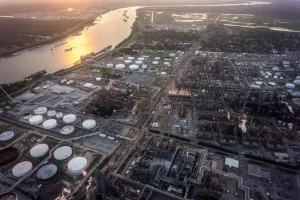Environmental Racism and State Negligence: The Case of Cancer Alley
Introduction:
Environmental Justice is the equitable treatment and effective involvement of all people regardless of race, color, national origin, or income with respect and full enforcement of environmental law. Unfortunately, in America, environmental racism— the unequal exposure of communities of color to hazardous environmental risks— continues to be a contingent injustice in the United States (Bullard, 2000).
One of the most prominent examples is found in “Cancer Alley”, an 85-mile stretch along the Mississippi River in the state of Louisiana. This place is home to over 150 petrochemical plants and refineries (Lerner, 2005). This region consists of predominantly Black, low-income communities, who experience some of the most extreme cancer rates in the country. This is due to the outcome of negligence to environmental policies and failure from the state level to execute legislative order across diverse populations in a fair manner (Mohai et al., 2009).
This chapter will study how environmental racism in Louisiana has allowed industrial development to persist without legislative checks. It will address the unfortunate results of the lack of industrial supervision by the state governments and the health risks local residents experience as a result of negligence in the federal level. Grassroots movements will be highlighted due to notable initiatives to address environmental justice. In assessing these topics, this chapter will deliver a comprehensive understanding of repeated patterns of environmental injustice in the United States while demonstrating how marginalized regions across the United States, including those in the prison system, are unequally susceptible to environmental harm.

Background on Cancer Alley:
Cancer Alley is an 85-mile corridor located on the Mississippi River between Baton Rouge and New Orleans, Louisiana, highly known as a hotspot for the petrochemical industries. Over 150 petrochemical plants and refineries run on this stretch of land, making it one of the most prevalent industrialized places in the United States. Referring back to U.S. environmental history, this region was home to plantations between the 18th and 19th centuries. Once the abolition of slavery took place, many former African American slaves resided in those areas. Today, the residents that live in Cancer Alley consist mostly of Black residents who are low-income. This unfortunate pattern of environmental injustice ties to the racial and economic marginalization on a national and regional scale.
The immediate industrial development of Cancer Alley started in the mid-20th century, when chemical companies began orchestrating plans to take advantage of the lax environmental regulations. Lax environmental regulations are rules or laws that address the protection of the environment in ways that are ineffective, weak, or have too many loopholes. Along with the enforcement of lax environmental regulations, cheap land prices, and the political marginalization of the local populations, gave big name corporations a green light to financially benefit from vulnerable communities. There is ample evidence to support the link between industrial pollution and its harmful health outcomes. Data shows that since industrial expansion has began, high rates of cancer, respiratory diseases, and reproductive health problems have increased dramatically. This becomes an environmental crisis because despite ample evidence that signals a need for environmental justice reform, there has been minimal state and federal intervention.
The name “Cancer Alley” became popular in the 1980s as environmental activists and local residents began raising awareness about the critical health impacts these communities experience as a result of the close proximity to industrial facilities. Several studies have affirmed that people living in Cancer Alley experience much higher cancer risks than the national average, specifically from pollutants like benzene, chloroprene, and formaldehyde—chemicals that petrochemical plants often release into the atmosphere.
The sad history of Cancer Alley paints a complicated portrait of how complex topics like race, socioeconomic status, and environmental health, present a valid case study in evaluating environmental racism in the United States.
State-Level Failures and Legislative Injustice:
The environmental concern in Cancer Alley addresses a broader matter in question: the failure from the state government to execute environmental protection regulations in an equitable manner. Unfortunately, even with federal environmental laws like the Clean Air Act and Clean Water Act, enforcement usually ends up in the hands of state regulators. In Louisiana, agencies have a historical demonstration of environmental leniency when dealing with major industrial polluters. This repeated action is a clear message to residents that economic growth is favored over the health of communities and environmental justice.
The Louisiana Department of Environmental Quality (LDEQ), were tasked with the regulation of industrial emissions and the initiation of public health protections. This department has been criticized for helping petrochemical corporations meet their interests over environmental priorities. Studies have shown that permits to build new plants are generally approved even in regions that are already environmentally burdened with high pollutions rates that heavily exceed safe limits (ProPublica, 2019). This pattern of regulatory violation shows the evident loophole in environmental law that allows the harmful impacts to occur amongst vulnerable populations.
